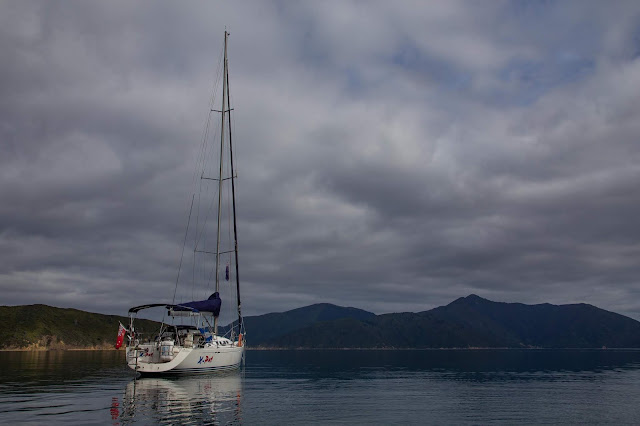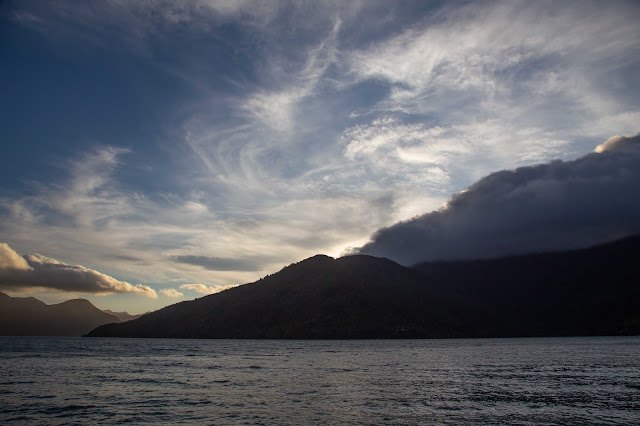It’s
been a busy week. We left our Adele Island anchorage last Saturday and headed
across Tasman Bay in very little wind to Nelson. We should have had good views
of the mountains to the south but these were completely obscured by the smoke
from the bushfires, which have enveloped Pigeon Valley, just south of Nelson.
We
arrived into the marina around 1330 and headed off into the city (20 mins walk)
to explore. Nelson really is a nice place, with lots of good food, craft beer
and arts and crafts shops. We explored the shops, had a nice meal and sampled
some very good craft beer at the Free House pub, which is in an old church.
There were many beers on offer and it took considerable self-control to leave
and not stay there all afternoon!
 |
| All tied up in Nelson Marina |
 |
| Street dining, Nelson style |
On
Sunday we had lazy start and then headed into Nelson for more exploration. We
visited a Sunday market full of bric-a-brac and books. There’s certainly plenty
of recycling going on in Nelson. We watched one young lad buy a pan for gold
panning, off to make his fortune no doubt. We then headed up to the cathedral,
which was built in the 19th century and sits on a hilltop looking
back over the main street. The cathedral grounds are filled with some very
impressive old trees, some of which are as old as the cathedral. Then we headed
down to the museum to find out more about the history of Nelson and read some
of the stories about previous inhabitants and also walked around an impressive
exhibition on Permian monsters, the predecessors to the dinosaurs.
 |
| Nelson Cathedral |
Back
on board X-Pat, we had Mike and Karen (SV True Companions) and Fleur who is a
local yachtswoman and member of the “Women who Sail” group, which Debi and
Karen also belong to. As is often the
case, the wine and beer just slipped down and before we knew it Karen was
throwing bubbly all over the boat as if we were doing a relaunch!
Feeling
slightly subdued the next morning, Pat borrowed a bike from Mike and Debi hired
one and we set off to, would you believe it, go wine tasting. Debi chose some distant
winery and off we went along wonderful coastal cycle paths to the Seifried
winery. Cycling along the side of the mudflats here gave a real appreciation of
the wonderful estuarine habitat that exists here. In places it was flanked by
some industrial development including a big wood processing factory and a
recycling centre and yet the environment was pristine.
 |
| On yer bike! |
Having
sampled seven of Seifried’s best and discovered that they no longer did lunch
we headed back towards Nelson feeling hungry, sore and a bit tipsy. We
eventually got back to a country pub, which goes by the dubious name of “The
Honest Lawyer”. Food and beer were both sampled and both good! We left to find
our next stretch of the coastal cycle route was heading into a strong northerly
wind, which slowed progress but we eventually arrived at our next stop, “The
Boat Shed” for cocktails! Sitting out over the water and watching the yachts
sail by we contemplated whether we would be able to walk the next day having
cycled 52km. It was a quiet evening.
On
Tuesday we hired a car with Mike and Karen and headed off to Collingwood, about
two hours west of Nelson. We stopped at Te Waikoropupu Springs on the way.
These springs discharge an amazing 14,000 litres of crystal clear water per
second, making them the largest natural springs in the southern hemisphere. The
flow rate apparently fluctuates twice daily with the tides, even though they
are 50m above sea level. It was all we could do to stop Mike going for a swim.
 |
| The beautiful clear waters at Te Waikoropupu Springs |
Once
in Collingwood we checked into our motel and then did a quick trip to Wharariki
Beach for some very windy sundowners. Thank you Fleur for the recommendation! This
all took a bit longer than expected and it was 8pm before we wandered into a
local restaurant called MAD which was all about sustainable living. The décor and food were very interesting and,
even though the place was supposed to have stopped serving, the very kind
proprietor said they’d feed us. It was a
delicious meal.
 |
| A windy Wharariki Beach |
We
stayed overnight in Collingwood and the next morning, were up early for a tour
of Farewell Spit. The natural sand spit is around 30km long and forms the
northern shore of Golden Bay. We were driven in a 4WD bus mainly on the north
shore of the spit, which comprises sand dunes exposed to the Tasman sea. The
material that forms the spit is apparently eroded from the southern highlands
and is swept up the west coast by the current. We headed out to the lighthouse,
which we had used as reference on our approach into Tasman Bay a week ago. When
it was built in 1897 the lighthouse was at the end of the spit, but the spit
has now extended more than 8 km to the east of the lighthouse.
 |
| Farewell Spit Lighthouse |
As
the tide turned we headed back to the west and stopped to climb the sand dunes.
This gave us a great opportunity to look south and see the very different
environment on the south side of the spit. The very shallow nature of Golden
Bay combined with a tidal range of over 4m means that when the tide goes out it
really goes out. At times it can recede 7km and exposes around 80 square
kilometres of mud flats. This is a fantastic feeding ground for wading birds
including thousands of Godwits. However it also creates a trap and whale
strandings are a common occurrence here.
 |
| 80 square kilometres of feeding grounds for waders |
 |
| Some mad people up a dune |
 |
| Cape Farewell, the most northerly point on South Island |
Back
in Nelson, Thursday was spent doing provisioning and cleaning ready for our
departure once again. We set off on Friday morning and headed north-east through
French’s Pass between D’Urville Island and the mainland and anchored in Deep
Bay for the night. The bay lived up to its name but we managed to anchor in
about 17m of water in the northern corner of the bay.
 |
| Heading through French's Pass |
Unfortunately
a wind change occurred overnight and we were woken at 0400hrs by our anchor
alarm. A quick check of the instruments indicated that were had dragged our
anchor and were close to the shore. The depth now read 3.5m! We started the
engine and headed back into the middle of the bay in the pitch dark and reset
the anchor. We then sat for an hour and watched nervously as the boat swung
around the bay in the gusts. When we swung back towards the beach and the depth
again dropped to below 4m we decided it was time to leave so we picked our way
out the bay between the marine farms and headed for Pelorus Sound in some very
gusty (35kts) conditions.
We
are now safely anchored in a very nice sheltered area called Ketu Bay and just
chilling out. Dragging anchor was a first for us and we don’t want to repeat
it!



























